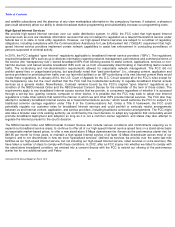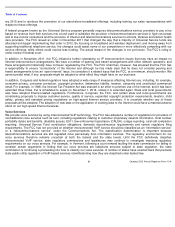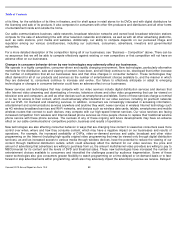Comcast 2013 Annual Report Download - page 28
Download and view the complete annual report
Please find page 28 of the 2013 Comcast annual report below. You can navigate through the pages in the report by either clicking on the pages listed below, or by using the keyword search tool below to find specific information within the annual report.
Table of Contents
is considering proposals to establish presumptions that would make it easier for multichannel video providers to succeed with
complaints involving exclusive contracts and to make it easier for them to use buying groups and for such buying groups to pursue
complaints under the rules. It is uncertain whether the FCC will act on these proposals and, if adopted, what impact these proposals
would have on our cable networks.
The FCC launched a rulemaking in 2007 to consider whether companies that own multiple cable networks should be required to
make each of their networks available to multichannel video providers on a stand-alone or “unbundled”
basis when negotiating
distribution agreements, although it has not further acted on that rulemaking. We currently offer our cable networks both on a
bundled and, when requested, on a stand-
alone basis. Increased regulatory requirements imposed on the manner in which we
negotiate programming distribution agreements with multichannel video providers may adversely affect our cable networks
business. In addition, various legislative proposals have been introduced in Congress that, if ever enacted, would mandate that
programmers offer cable networks to multichannel video providers on an a la carte basis and would provide certain program-
access
rights and protections to
online video distributors. It is uncertain whether any of these proposals will ever be adopted and, if
adopted, what impact these proposals would have on our cable networks.
Under the terms of the NBCUniversal Order, multichannel video providers can invoke commercial arbitration for program access in
certain circumstances against our cable networks and broadcast television networks, including our regional sports networks. In
addition, under the NBCUniversal Order and NBCUniversal Consent Decree, we are required to make certain of our cable network,
broadcast television and filmed entertainment programming available to bona fide online video distributors in certain circumstances,
and they may invoke commercial arbitration pursuant to conditions adopted in the NBCUniversal Order and NBCUniversal Consent
Decree to resolve disputes regarding the availability of, and the price, terms and conditions of access to, such programming. For
further discussion of these conditions, see “Broadcast Television” below and refer to the “Must-Carry/Retransmission Consent”
and
“Internet Distribution” discussions within that section.
Children’s Programming
The Children’s Television Act (“CTA”)
and FCC regulations limit the amount and content of commercial matter that may be shown
on cable networks, broadcast networks and broadcast television stations during programming originally produced and broadcast
primarily for an audience of children under 13 years of age. FCC regulations also limit the display during children’
s programming on
cable or broadcast of Internet addresses of websites that contain or link to commercial material or that use program characters to
sell products. Similarly, FCC regulations prohibit the display of commercials during children’
s programming on cable or broadcast
networks that use program characters to sell products when the commercial is adjacent to children’
s programming in which the
characters appear. The FCC is currently considering whether to prohibit interactive advertising during children’
s television
programming. The NBCUniversal Order includes certain commitments and conditions related to children’
s television and advertising
directed at children, including commitments that we will not insert interactive advertising into children’
s television programming in
any of the advertising spots we control, either as a multichannel video provider or as the programmer, and that we will provide at
least $15 million worth of public service announcements on childhood obesity, FDA nutritional guidelines, digital literacy and
parental controls per year until 2016.
Broadcast Television
Licensing
The Communications Act permits the operation of local broadcast television stations only in accordance with a license issued by the
FCC upon a finding that the grant of the license would serve the public interest, convenience and necessity. The FCC grants
broadcast television station licenses for specific periods of time and, upon application, may renew the licenses for additional terms.
Under the Communications Act, broadcast
23
Comcast 2013 Annual Report on Form 10
-
K
























